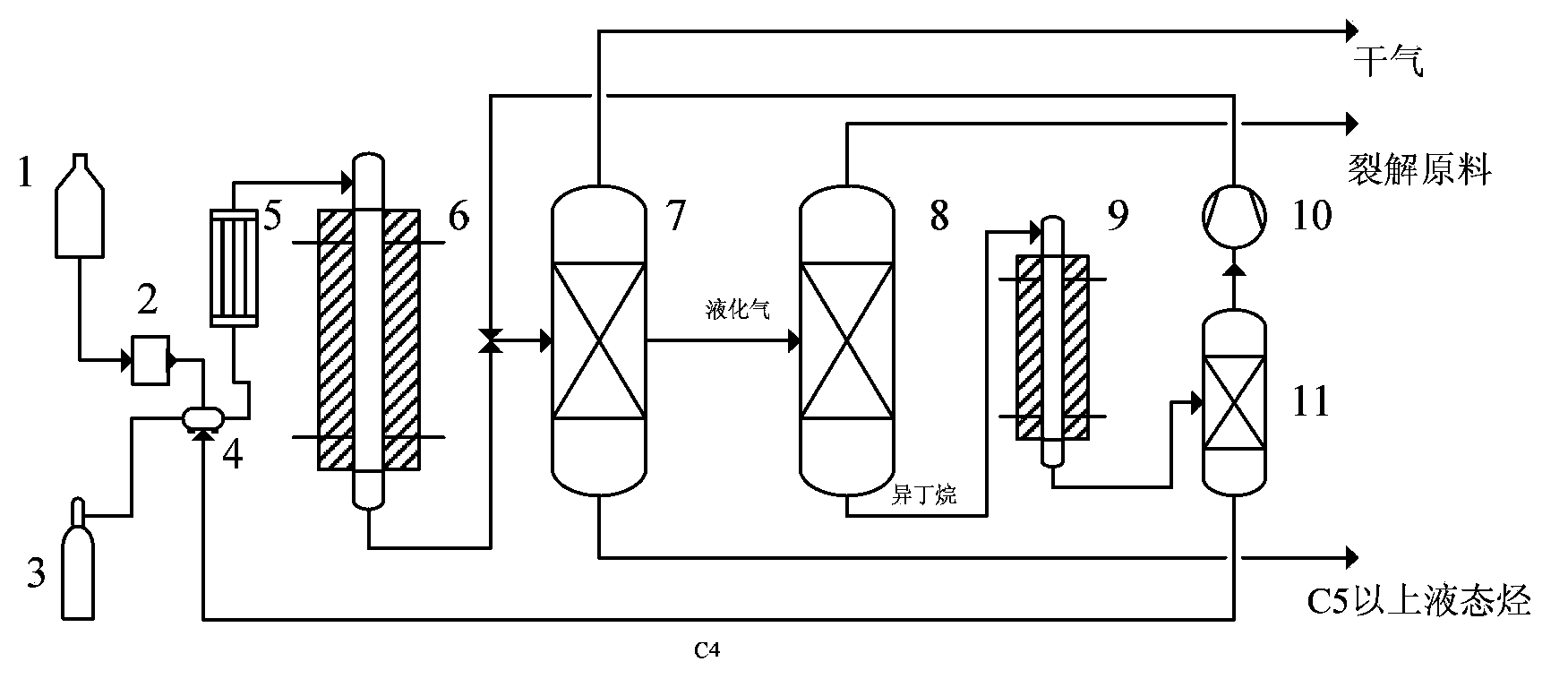Method for producing high octane number gasoline blending component through mixing C4 hydrocarbon aromatization
A technology of aromatization and carbon tetrahydrocarbons, which is applied in the production of liquid hydrocarbon mixtures, the treatment of hydrocarbon oil, and the petroleum industry. Improved cracking performance and good economic benefits
- Summary
- Abstract
- Description
- Claims
- Application Information
AI Technical Summary
Problems solved by technology
Method used
Image
Examples
Embodiment 1
[0032] Using C4 as a by-product of a refinery as a raw material, its composition is shown in Table 1:
[0033] Table 1 Raw material composition
[0034]
[0035] The aromatization catalyst is ZSM-5 molecular sieve. After being treated with steam at 520°C for 12 hours, tungsten nitrate and cobalt nitrate are impregnated on the molecular sieve so that the weight content of tungsten and cobalt are 1.5% and 3.5% respectively. The aromatization reaction conditions are: reaction temperature 340°C, reaction pressure 2.0MPa, total hydrocarbon feed space velocity 1.0h -1 , the reaction condition of hydrogen oil ratio 50 (v / v), the isobutane dehydrogenation catalyst prepared according to Example 7 in CN 1185994A is loaded in the dehydrogenation reactor, reaction temperature 560 ℃, feeding space velocity 100h -1 .
[0036] Reaction results: The yield of each component in the system is: dry gas 4.72%, cracked material yield 24.12%, liquid hydrocarbon yield above C5 71.16%, and octane...
Embodiment 2
[0043] The C4 aromatization method is the same as in Example 1, and the aromatization catalyst SIHZSM-5(A)-08 prepared according to Example 9 in CN1586721A is loaded into the aromatization reactor, the reaction temperature is 380°C, and the reaction pressure is 2.5MPa , total hydrocarbon feed space velocity 2.0h -1 , the reaction condition of hydrogen oil ratio 150 (v / v), the isobutane dehydrogenation catalyst prepared according to the embodiment 2 in CN 1185994A is loaded in the dehydrogenation reactor, reaction temperature 620 ℃, feeding space velocity 300h -1 .
[0044] Reaction results: The yield of each component of the system is: dry gas 7.87%, cracked material yield 23.17%, liquid hydrocarbon yield above carbon five 68.96%, octane number 94.6. The composition of cracking raw materials is: propane 62.07%, n-butane 36.71%.
Embodiment 3
[0046] The C4 aromatization method is the same as in Example 1, and the aromatization catalyst SIHZSM-5(A)-07 prepared according to Example 9 in CN1586721A is loaded in the aromatization reactor, the reaction temperature is 340°C, and the reaction pressure is 1.5MPa , total hydrocarbon feed space velocity 1.5h -1 , the reaction condition of hydrogen oil ratio 100 (v / v), the isobutane dehydrogenation catalyst prepared according to the embodiment 3 in CN 1185994A is loaded in the dehydrogenation reactor, reaction temperature 590 ℃, feeding space velocity 150h -1 .
[0047] Reaction results: The yield of each component of the system is: dry gas 5.41%, cracked material yield 23.91%, liquid hydrocarbon yield above carbon five 70.78%, octane number 95.9. The composition of cracking raw materials is: propane 60.62%, n-butane 38.19%.
PUM
| Property | Measurement | Unit |
|---|---|---|
| research octane number | aaaaa | aaaaa |
| research octane number | aaaaa | aaaaa |
| research octane number | aaaaa | aaaaa |
Abstract
Description
Claims
Application Information
 Login to View More
Login to View More - R&D
- Intellectual Property
- Life Sciences
- Materials
- Tech Scout
- Unparalleled Data Quality
- Higher Quality Content
- 60% Fewer Hallucinations
Browse by: Latest US Patents, China's latest patents, Technical Efficacy Thesaurus, Application Domain, Technology Topic, Popular Technical Reports.
© 2025 PatSnap. All rights reserved.Legal|Privacy policy|Modern Slavery Act Transparency Statement|Sitemap|About US| Contact US: help@patsnap.com



